Heracleion
|
For centuries it was thought to be a legend, a
city of extraordinary wealth mentioned by Herodotus, visited by Helen of
Troy and Paris, her lover, but apparently buried under the sea. In fact,
Heracleion was true, and a decade after divers began uncovering its
treasures, archaeologists have produced a picture of what life was like
in the city in the era of the pharaohs. The city, also called Thonis,
disappeared beneath the Mediterranean around 1,200 years ago and was
found during a survey of the Egyptian shore at the beginning of the last
decade. Now its life at the heart of trade routes in classical times are
becoming clear, with researchers forming the view that the city was the
main customs hub through which all trade from Greece and elsewhere in
the Mediterranean entered Egypt. |
 This drawing and the above paragraph are taken from here |
|
But what caused the disappearance of
Heracleion from the face of the earth. Several possibilities were put
forward, from Tsunami to earthquake to a sudden sinking. If the people
of Heracleion had time to escape a sinking city, why was so much gold
and religious artifacts left in situ? Next to what was the temple lies
the wreck of a large shipping vessel. The top of the ship is littered
with remains of a temple wall, and of pillars. This was the reason for
the shipwreck, a collapsing temple. Heracleion was built in completely the wrong place and was very lucky to have survived as long as it did. Already in decline as a major seaport, it was doomed to sink from a process known as liquifaction. Alexander had, by the time, built Alexandria as Egypts new major seaport. Much of Egypts trade was by now processing via Alexandria. A shift in the substrate on which Heracleion was built cause the 'bed' to settle, to compress, and this forced water upwawards to liquify the very land upon which the city stood. The area of the city measured some 1.8 km by 1.5 km, so a sizeably weight in stone was standing on the land that was liquifying. The city sank under its own weight. The liquifaction could have been brought about by a minor tremor or an increase in tidal activity, eg: Tsaunami. |
| A recent programme on tv highlighted the efforts of divers who found, catalogued and retrieved some amazing artifacts, most of which were actually still intact and undamaged by the 2000 years they sat on the sea bed 6km off the present coast of Eqypt. The stele for example pictured below was completely intact. Until its discovery in 2000AD, many wrote Heracleion off as a myth, similar to the story of Atlantis. |
|
The international research team have also
discovered remnants of the legendary temple of Amun-Gereb where the
Pharaohs was invested with the power to rule Egypt. The temple was the
centre point of Heracleion from which a web of canals and channels
connected other parts of the city together. |
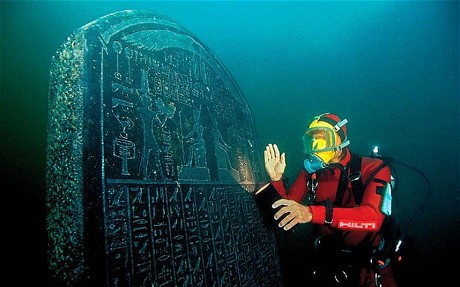 Photo: Christoph Gerigk |
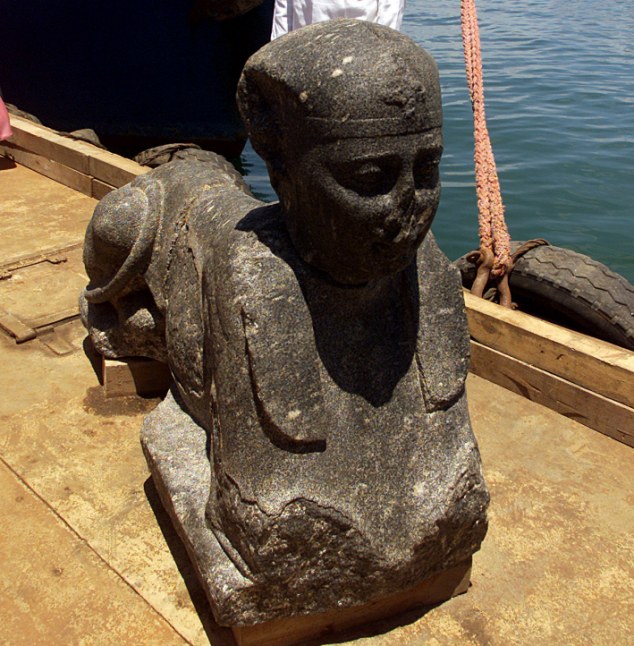 |
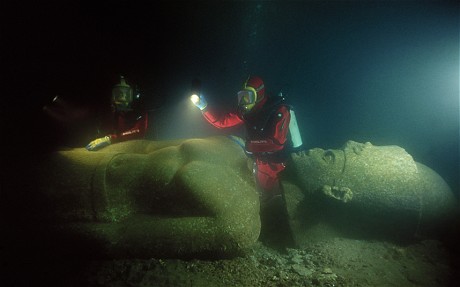 Photo: Christoph Gerigk |
|
Giant 16ft statues have been reassembled on the seabed 150ft below the surface before being brought ashore, as well as hundreds of smaller statues of Egyptian gods. Other finds include stone blocks with both Greek and Ancient Egyptian inscriptions and dozens of sarcophagi believed to have contained mummified animals offered as sacrifices to Amun-Gereb. The research team, led by Dr Goddio have yet to establish what cause the city to go down, but the main theory is that the unstable sediments Heracleion was built on collapsed, and in combination with a rising sea-levels, may have caused the entire area to drop 12 feet straight into the water. |
| http://www.youtube.com/watch?v=SXJusQqehdc |
| The city sank in the 3rd or 2nd century BC but many amateur video and image sites give wildly differing ages of the city, some as little as 800 years ago? Try over 2000 years eh? |
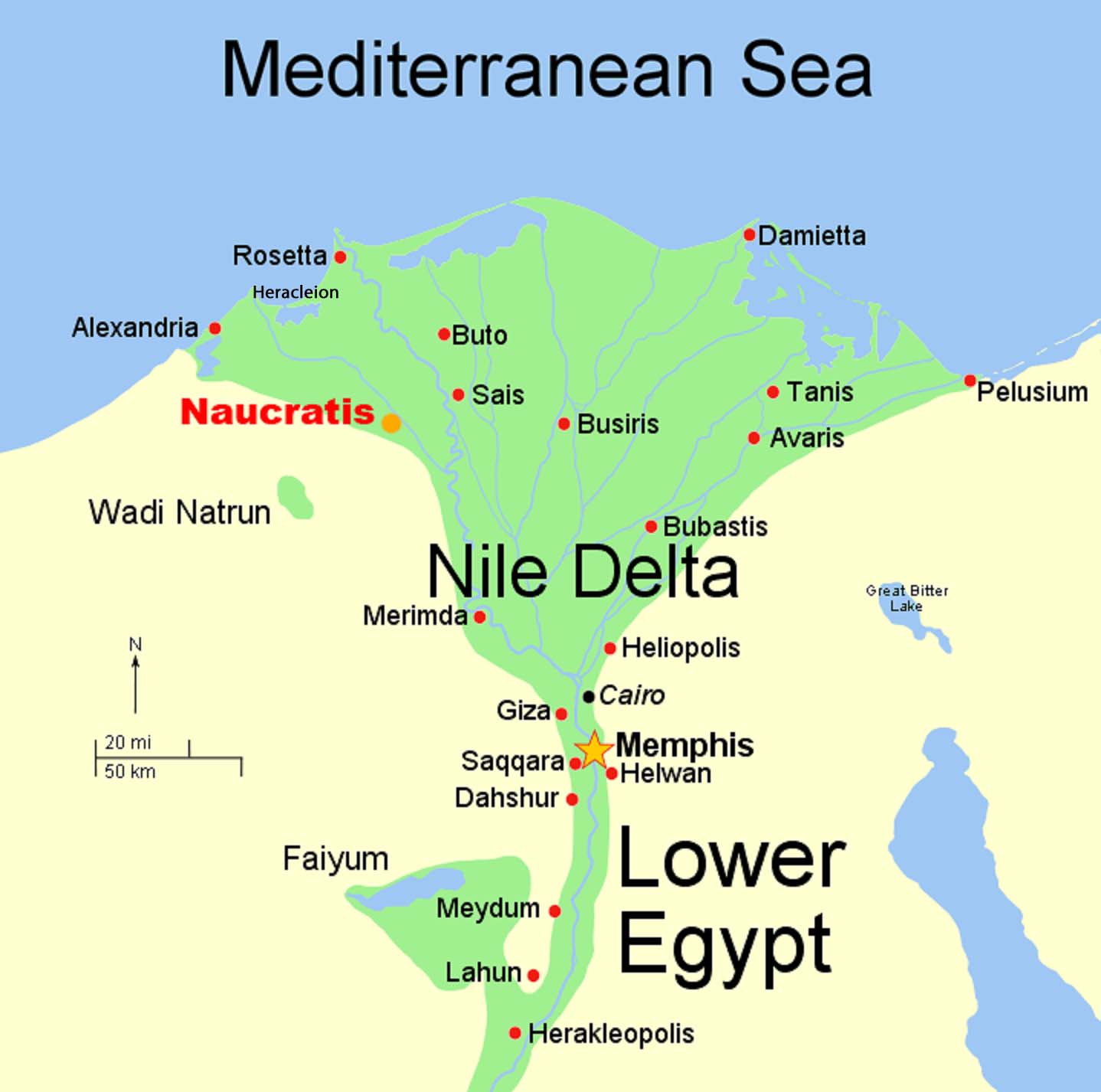 |
| Heracleion stood on the approimate position marked and the significance of Naucratis is that it was the sister port to Heracleion. Naucratis received good transfered up the Nile from Heracleion by smaller 28 meter river boats. A complete remains of one of these 28 meter boats has been found in Heracleion. |
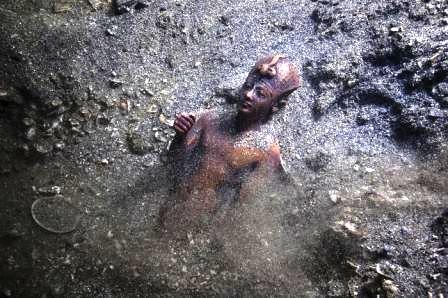 |
| This complete statue was found in the preserving silt and is of exceptional workmanship. It would have been presented to the gods at the temple by a pharaoh himself. |